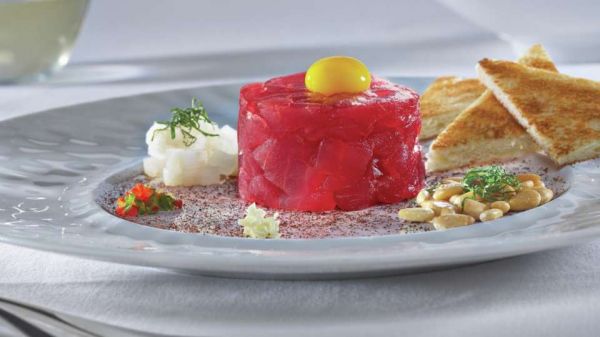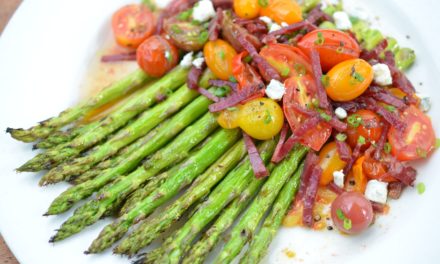“I was always told to use the proper tool for the proper job,” said chef Michael Mina, reflecting on the importance of correct knife use in the kitchen. Many chefs, including Mina, have perfected their knife skills to create the best dishes possible. “The saying was always small job, small knife, large job, large knife.” Knives are a very important chef’s tool, and the different types of knives as well as the different cuts are concepts that every chef, even those just starting at home, should understand.

“For fine slices and dices, I like to use Japanese chef knives. My personal favorite knife is a 210mm Gyuto Japanese knife.”
For sushi and sashimi dishes that require fine slicing, like this Tartare of Ahi Tuna, Michael Mina recommends a sharp Japanese chef knife. Photos: courtesy of Michael Mina
When starting to prepare ingredients, chefs first need to ensure they are using the right type of knife. Mina explained the different knives he uses for the many cutting tasks he takes on. “For fine slices and dices, I like to use Japanese chef knives. For heavy duty tasks like splitting pumpkins and gourds, I like to use a 10 to 12-inch heavy duty German steel knife like a Wustof. For carving meats, I like to switch between a Japanese Sujihiki slicer or a serrated slicer with a length of nine to 10 inches long.” His personal favorite is the 210mm Gyuto Japanese knife.
For those hoping to master their knife skills at home, Mina recommends “starting with a small paring knife and doing small cuts such as cutting asparagus stalks so you get used to the motions.”
Main Dish
Tartare of Ahi Tuna
Serves 4 | By Michael Mina

Tartare of Ahi Tuna
Serves 4 | By Michael Mina
1 pound sashimi grade tuna, cleaned
¼ tablespoon garlic, minced fine
2 pears, skins removed and cut into small dice
1 tablespoon lemon juice, mixed with 1 cup water for holding pears
2 green jalapeno, minced, seeds reserved
2 red jalapeno, minced, seeds reserved
¼ bunch mint leaves, picked from stems and cut into chiffonade
6 tablespoon pine nuts, toasted
¾ cup sesame oil, chili infused
8 slices of white bread for toast
6 quail Eggs, separated. Yolks reserved (whole)
1 ½ tablespoon salt
½ tablespoon white pepper
2 tablespoon ancho chili powder
To prepare
Cut the tuna into small cubes. Be sure that no sinew is left behind. Store chilled. Remove the seeds and pith from the chilies, reserve. Dice the chilies into a fine brunoise and mix the colors together. Add the chili seeds and scraps to the sesame oil. Heat very lightly and allow the chilies to infuse the oil. Strain through a fine mesh strainer when the desired heat is achieved. Cool. When all of the other ingredients are prepared you are ready to plate.
To plate
Be sure that the plates are well chilled to ensure the dish is served cold. Working with 2½ inch x 3 inch ring mold pack the tuna firmly and evenly in the mold. Unmold into the center of the plate being sure to make a small indention with your finger in the center of the top. This will give the egg a resting place. Drain the pears thoroughly and place 2 tablespoons at the 9 o’clock position. Place about 1½ teaspoons of the minced chilies at 7 o’clock, 1/16 teaspoon of garlic at 5 o’clock and 1 ½ tablespoons of pine nuts at 3 o’clock. Adjust these amounts depending on your personal taste. Season with about 1/3 tablespoon salt and a pinch of white pepper over the top of each plate. Sprinkle evenly with ancho powder and mint. Place a quail egg yolk on top of the tuna mold. Drizzle 3-4 tablespoons of the infused sesame oil on top of and around each plate. Serve with toast points (crusts removed).
To serve
Using a fork and spoon, mix the ingredients vigorously in front of the guests or get everyone involved in the process. Once everything is well mixed, reshape the tuna into an appealing shape, i.e. square or triangle.
Alternate preparation
All of the ingredients can be mixed in a bowl ahead of time and then molded and served. In this case you would want to reserve enough ancho powder and mint to garnish the plates.



